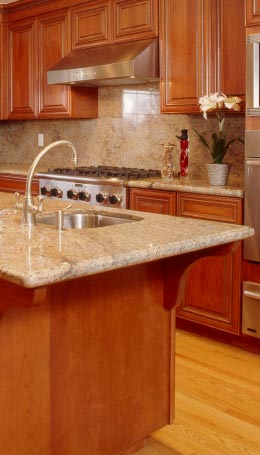Granite Countertops
What do granite countertops look like?
No two granite countertops are exactly alike, and this uniqueness is what makes them so popular. Granite countertops are coarse-grained and modern-looking, and blend well with other popular building materials such as stainless steel, burnished wood, and concrete.; Granite countertops have an intricate gradient of colors, textures, and shades, making it an interesting accent to a plain tiled wall.
Granite is very versatile when it comes to aesthetic quality. Depending on your existing home décor, granite countertops can create a classic Romanesque feel, or provide a more modern look.
There are three basic elements that make granite countertops distinct. These are the rock color, the graining, and the edge cutting and finishing techniques.

Color
Granite is naturally either gray, beige, or black, depending on the chemical composition of the rock. Black granite generally has a high amount of carbon in it, while gray granite is composed of a fusion of quartzite and carbon. Beige granite is usually reformed sandstone, with the grain and roughness eroded by the heat, resulting in a smooth, polished stone with an interesting grain pattern.
Some homeowners find these base colors too drab, and while these neutral colors match with anything, some people look for specific colors that match their home’s fixtures better. This is why granite manufacturers and dealers came up with engineered granite. Using advanced geological treatments and strong dye chemicals, granite countertops are now available in a wide range of colors.
 Graining
Graining
Graining in granite refers to the bits of foreign material that give granite its unique texture and tone. Generally, as more foreign material is infused into the granite, a more varied and intricate texture results. Some granite countertops have specks of formed carbon or quartz embedded in the stone, while others have larger particles of calcified wood, which is usually white or gray.
Some models even have very fine veining and channeling, which results from molten rocks that cool slowly and continue to trickle as the rest of the granite hardens. Base elements are prevented from collecting in a particular area, and are forced to cool while still in liquid form. Since they remain liquid, they are solidified while spread out, creating webs and line patterns in the rock. Prized granite samples may even have bits of smoked glass inside.
Finishing techniques
Unlike fresh slate and limestone, granite is usually treated and cut with a stone cutter into tiles, steps, and countertops. Slate and limestone tend to chip or shatter from the impact of a stone cutter, but because granite is very compact, it can handle and yield to impact very well.
While traditionally shaped granite countertops, such as round or rectangular ones, look great in most homes, many people prefer a free-form design to give their granite countertop more character. Granite countertops have been made to resemble breaking waves, curves, and other irregular shapes. However, custom-cutting takes a lot of skill. If you want a custom-shaped granite top, look for a reputable builder and be very clear about your preferences.